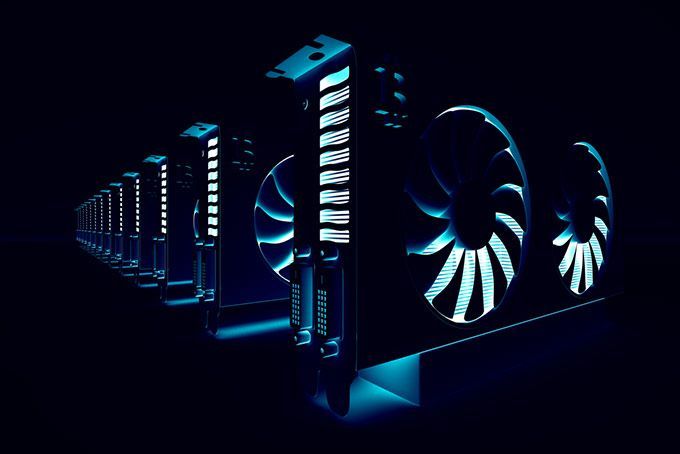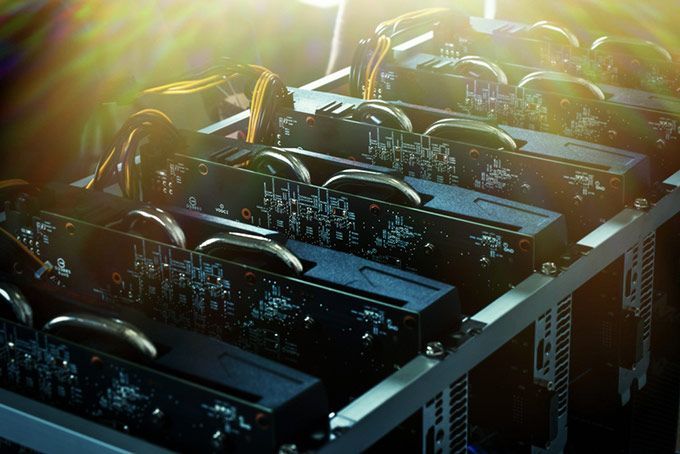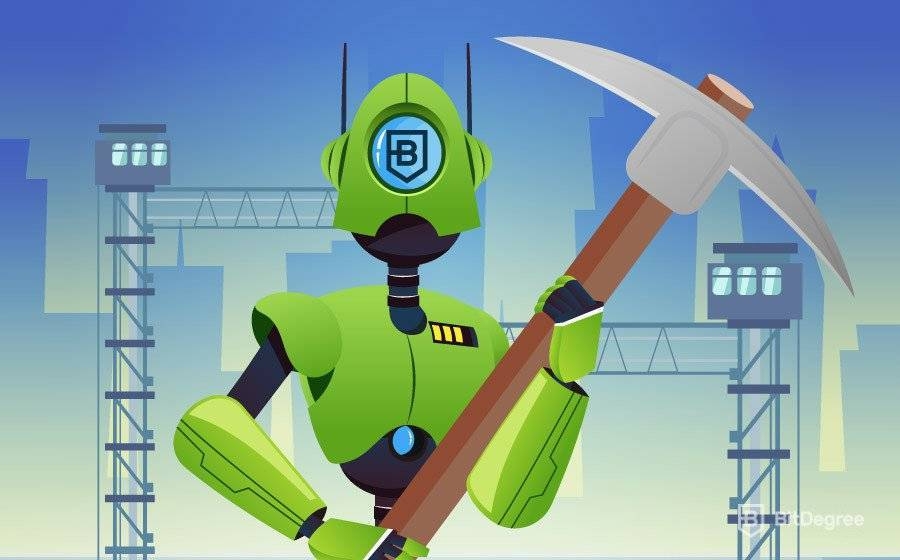Free Airdrop Season 7 is LIVE! Answer fun questions or do simple tasks to earn rewards from the $30K BitDegree prize pool. Participate Now ! 🔥
If you liked playing archeologist-types of games when you were a kid and DIY videos are a usual sight in your YouTube playlist, then you have come to the right place. Today I’m going to tell you about all of the different ways on how to build a mining rig.
Mining rigs might seem tricky at first, but when you break them down, it’s not that hard. In this guide, we’ll cover some of the basic things about mining rigs: their components (and what are the best component manufacturers), how they work, best placement ideas and so on.
Also, if you want to invest in cryptocurrencies, you can check out such platforms as Binance, Coinbase, Kraken, and KuCoin. Furthermore, if you feel like building a rig of your own isn't actually for you, you can also check some cloud mining alternatives - platforms such as CCG Mining and Genesis Mining.

|

|
|
|---|---|---|
| Advanced Users & Beginners | Advanced Users & Beginners | |
| United States, United Kingdom, Germany, Canada, France, + 100 more | Turkey, Argentina, Vietnam, Ukraine, + 180 more | |
| All Coinbase Coupons | See All Coupons of Best Exchanges | |
| A reliable, well-known and respected cryptocurrency exchange platform. | One of the leading crypto exchange platforms in the industry. | |
|
Visit site
Read review |
See TOP10 Brands
Read review |
We’ll start with the definitions and then work our way from there.

Did you know?
Subscribe - We publish new crypto explainer videos every week!
What is Uniswap? (UNI Token Explained With Animation)


Table of Contents
Types of Mining Rigs
Just like cryptocurrency wallets, there are three different types of mining rigs:
Latest Deal Active Right Now:Head to BitDegree Missions, gather as many Bits as possible & claim your stake of the $30,000 Prize Pool! Don't waste your time & start collecting Bits by completing Missions and referring friends.
- CPU. CPU mining rigs utilize processors to “mine” data from the blockchain. These are very simple and inexpensive rigs - most people, when they talk about CPU mining, mean that they mine cryptocurrencies straight from their computer. This has its benefits and drawbacks (having much more of the latter).
CPU mining is becoming more and more unpopular as the years go by. There are many contributors to the reasoning behind this, however, one of the bigger ones is the price. CPU mining is very costly and clunky - your electricity bills are going to skyrocket through the roof, while your computer might overheat at any given second if you lack proper cooling.
The main perk that the CPU method of mining has is its availability. You could download a few programs (more on them later) to your desktop or laptop (although using laptops for mining cryptos is strongly unadvised) and start mining right this instant. People who don’t want to invest a lot (or any) of money favor CPU mining because it requires zero effort. - GPU. GPU cryptocurrency mining rigs are the absolute favorites for people looking at how to build a mining rig. They’re definitely among the most popular crypto farming methods out there - anyone from a single miner to a corporation, possessing a whole mining farm, tend to use GPU rigs. GPU mining rigs utilize graphics card GPUs to mine data from the blockchain.
 The biggest downside is its price. Graphics cards tend to be quite expensive (or very expensive, if you’re aiming for the best of the best), so the initial investment you might have to make could be somewhat significant. They also require maintenance - a lot of cooling, plenty of electricity to fuel their power, generally looking after and taking care of, etc.
The biggest downside is its price. Graphics cards tend to be quite expensive (or very expensive, if you’re aiming for the best of the best), so the initial investment you might have to make could be somewhat significant. They also require maintenance - a lot of cooling, plenty of electricity to fuel their power, generally looking after and taking care of, etc. - ASIC. ASICs, or Application-Specific Integrated Circuits, are special devices designed explicitly with one, designated purpose in mind. These devices are the current top-dogs when it comes to cryptocurrency mining rigs. Someone who’s looking for how to build a mining rig should know that, while not being rigs per say, ASICs are pieces of dedicated machinery that you can purchase and set up so it would mine cryptos for you.
They are very popular, which in turn makes them extremely scarce to come by. If making money through cryptocurrencies is your only objective, then ASICs are a perfect choice. However, if you care about the ecosystem that is the crypto world, you might want to think twice. Because of how powerful they are, ASICs have a reputation of twisting the wellbeing of cryptocurrencies and throwing miners that use other types of rigs out of balance. Because of these reasons, ASICs have recently been subject to a high level of controversy that sparked within the Ethereum mining community and continues to echo through ought the crypto world.
Because of how powerful they are, ASICs have a reputation of twisting the wellbeing of cryptocurrencies and throwing miners that use other types of rigs out of balance. Because of these reasons, ASICs have recently been subject to a high level of controversy that sparked within the Ethereum mining community and continues to echo through ought the crypto world.
These were the three types of the most commonly used mining rigs out there. Although the information may vary, the most popular out of the three stems to be the GPU type, with ASIC and CPU ones as follow-ups, respectively.
Now that you have a general understanding of the main types of mining rigs, their pros and cons, we can move on to the main topic at hand - how to build a mining rig?
How to Build a Mining Rig?
Let’s just say that when you’re thinking about how to build a mining rig, you’re thinking about a GPU one. ASICs are devices on their own (they require no initial building from your part), while CPU rigs are built in the same way as the GPU one, with their main component being the one differentiator.
Things to Keep in Mind
So how to build a mining rig? Well, first of all, you have to know what to take into consideration when picking the parts for your rig.
Naturally, there are quite a few things to keep in mind, but the main ones would probably have to be hashrate and energy consumption.
Hashrate defines just how powerful your rig is. It’s a way of knowing how many calculations your rig can perform in one second. The higher the amount, the better. Naturally, though, high hash rates mean high demand for power, which in turn results in a high electricity bill. For anyone thinking about how to build a mining rig, this should be a big factor to take into consideration.

Energy consumption is another major factor to consider when thinking about how to build a mining rig, and one people tend to disregard it. You should never let the illusion that “I bought my mining rig components, which means I’m done spending” get in your head. Mining energy costs might not only match your profits but even exceed them and leave you completely broke and in debt.
When choosing your hardware, always try to strike a perfect balance between the power of a component, and the power consumption.
Finally, don’t just jump into the first market site and buy everything that pops up on your screen when you Google “best hardware for building a mining rig”. With a little bit of digging, you might find the same components for a lot cheaper. Be smart - cryptocurrency mining is a competitive business, so every dollar counts!
Talking about hardware, you should know that it's crucial to get a reliable hardware wallet to protect your cryptocurrencies. A few of the recommended options include Ledger Nano X and Trezor Model T.
Components
Let’s make a quick overview of the components that you’ll need for building a mining rig. Note that you can find a variety of different components over at Parallel Miner.
Generally, what you’re going to look for are the following parts:
- Motherboard. This is one of the main components of your rig. Generally, a motherboard determines the rest of your parts in the rig (or, in other words, determines the compatibility of the rig). When choosing a motherboard, if it’s the first item you’re looking for, always check the graphics cards that it works well with.
- Graphics card(s). The GPUs are an essential part of your rig. They determine whether your mining rig is going to be top-notch or meh. The two main companies producing and selling top-tier graphics cards are Nvidia and AMD. When you pick your cards, remember to check online if they’re suitable for cryptocurrency mining. Remember, though, that a good rig has to be made out of several or more GPUs - plan your funds and other purchases accordingly when thinking how to build a mining rig.
- Power supply. The power supply that you’ll have to get depends solemnly on the other components of your rig. If you're trying to build a hardcore, supercharged cryptocurrency mining rig, then the power supply is going to have to match that. In most cases, though, a medium level power supply does the job perfectly.
- Cooling. An essential factor in any type of mining rig, cooling is going to ensure that your device works properly and prevents any type of possible overheating. Don’t be cheap and invest in the best cooling possible - it’s always better to be safe than sorry.
- CPU. A good processor is going to be key when it comes to being able to run the rig smoothly and without any significant faults or errors.
- Frame. A mining rig frame is the last key component that you’ll need (at least when it comes to GPU mining rigs). A mining rig frame is going to be the carcass of your device - these frames come in a wide variety of choices, and it’s preferential. Naturally, though, you’re probably going to want to use something sturdy and will hold the whole machine together, rather than a frame that’ll break from the first piece of dust that falls on to it.
With all of the parts acquired, let’s move on to the building process itself.
The Building Process
To be frank, the building process itself is quite straightforward. Let’s talk about how to build a mining rig.
The very first step that you’ll need to take is to set up the motherboard inside of the mining rig frame. Building a mining rig becomes that much easier when you’ve already picked a suitable spot for the rig to stay in, though, so pick a good spot in advance.

After you’ve set up the motherboard, plug the cables into the CPU. Set up the graphics cards and the rest of the needed hardware and plug the cables in, respectively.
Now that you’ve got the hardware in place, double-check the cable placement and if all’s well in place, it’s time to move on to the software.
Depending on the software you’ve chosen, your rig might have a few fancier functions, or be completely basic. Fancy doesn’t always equate to good, though, so pick a secure software, has a good reputation and works well.
The online crypto forums are an excellent place to look for and review cryptocurrency mining software. When thinking about how to build a mining rig, software shouldn’t be excluded from the picture - good software is often what makes it or breaks it.
After installing the software, configure the options to your liking and proceed with the setup. Your device will have to reboot a few times before it’s fully operational, so be patient.
After all of this is done, you can officially begin your career as a professional cryptocurrency miner!
Conclusion
As more and more people turn towards cryptocurrencies, there’s a vast increase in the need for experts in the field. People who have a comprehension of how to build their mining rigs are quite far ahead in the crypto department - after all, you don’t only learn about the rig itself, but about the software needed, how cryptos work, how to use the market, etc.
At this point, you should be at least somewhat knowledgeable on the topics of crypto mining rig hardware and software, how to choose certain specific items, what criteria to look at and what to ignore, how to assemble the rig itself, etc.
Be sure to put this knowledge to good use, and remember - Rome wasn’t built in a day. It takes a lot of practice to build a pristine mining rig, so don’t stress if it doesn’t work out for the first couple of times.
And remember, it’s always better to be safe than sorry. Choose the right equipment for the job, both from the hardware and the software standpoints. Don’t hesitate to invest in something that will not only do the job for you but will keep your funds secure and last for a long time, rather than breaking apart in the first couple of months. Decent equipment can do wonders - just don’t be afraid to experiment!
Also, if you want to keep your cryptocurrency safe, don't forget to use a secure wallet! Make sure to check out such options as Ledger Nano X and Trezor Model T. And, once again, if you've read this article, and have come to the conclusion that building mining rigs isn't for you, cloud mining remains a viable alternative!
CLAIM 10% DISCOUNT
On Best-selling Ledger Bundles!
For a limited time only, get Top-rated Ledger bundles for yourself and your loved ones with a 10% Ledger discount code. Take advantage of this valuable Ledger deal NOW!
The content published on this website is not aimed to give any kind of financial, investment, trading, or any other form of advice. BitDegree.org does not endorse or suggest you to buy, sell or hold any kind of cryptocurrency. Before making financial investment decisions, do consult your financial advisor.













